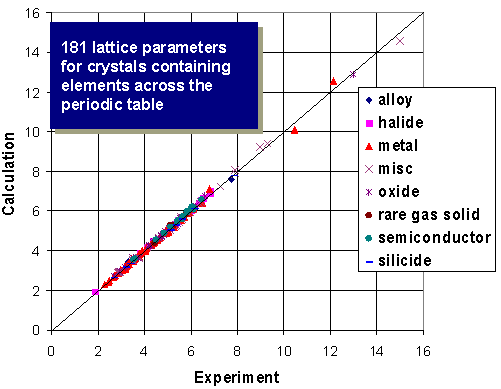CASTEP Geometry Optimization task
The CASTEP Geometry Optimization task allows you to refine the geometry of a 3D periodic system to obtain a stable structure or polymorph. This is done by performing an iterative process in which the coordinates of the atoms and possibly the cell parameters are adjusted so that the total energy of the structure is minimized.
CASTEP geometry optimization is based on reducing the magnitude of calculated forces and stresses until they become smaller than defined convergence tolerances. It is also possible to specify an external stress tensor to model the behavior of the system under tension, compression, shear, and so on. In these cases the internal stress tensor is iterated until it becomes equal to the applied external stress.
The process of geometry optimization generally results in a model structure that closely resembles the real structure.
The accuracy of the lattice parameters calculated using CASTEP is illustrated in Figure 1 (Milman et al., 2000).

Figure 1. Experimental vs. CASTEP calculated lattice parameters
Equation of state calculation
Geometry optimization under applied hydrostatic pressure can be used to determine the bulk modulus of a material, B, and its pressure derivative, B'=dB/dP. The procedure involves calculating a theoretical equation of state, EOS, which describes the dependence of the cell volume on the external hydrostatic pressure. The methodology is very similar to the real experiment: the external pressure is fixed using the Minimizer tab on the Geometry Optimization dialog and the cell volume at that pressure is found by carrying out geometry optimization with CASTEP.
The subsequent analysis of the P-V dataset is exactly the same as in experimental studies (see Winkler, 1999 for more details). An analytical expression is chosen to describe the EOS and its parameters are fitted to the calculated datapoints. The most popular form of EOS is the third order Birch-Murnaghan equation:

Where:
V0 is the equilibrium volume
A detailed comparative study of various analytical forms of EOS was performed by Cohen et al.(2000).
The values of B and B' obtained from such fitting experiments depend on the pressure range used in the calculations. Experimental values obtained using a diamond anvil cell are usually in the range 0-30 GPa, so this is the range recommended for theoretical studies. It is also important to avoid using negative values of pressure in such studies. In addition the pressure values used to create the P-V dataset should not be uniform. More accurate sampling of the low-pressure region is required to obtain an accurate value of the bulk modulus.
Geometry optimization methods
By default, CASTEP uses the BFGS geometry optimization method. This method usually provides the fastest way of finding the lowest energy structure and this is the only scheme that supports cell optimization in CASTEP.
The Damped molecular dynamics method is an alternative that can be as effective as BFGS for systems with a flat potential energy surface, for example molecular crystals or molecules on surfaces.
The TPSD geometry optimization algorithm is a viable alternative for systems where the potential energy surface deviates significantly from the quadratic form. TPSD offers robust convergence and is particularly recommended when user-supplied constraints on lattice parameters are applied during cell optimization (for example, when optimizing a solid-solid interface in a direction perpendicular to the interface plane).
See Also:
Geometry optimization
Setting up a geometry optimization
CASTEP Geometry Optimization - Setup